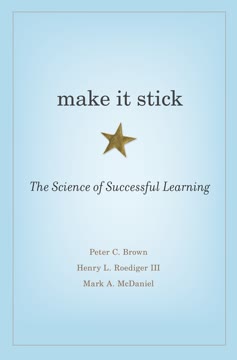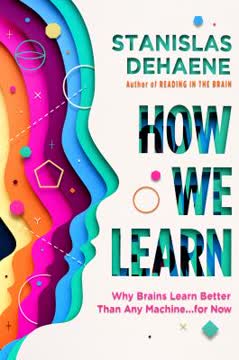Key Takeaways
1. Prior knowledge significantly impacts learning, both positively and negatively
Students' prior knowledge can help or hinder learning.
Building on foundations: Prior knowledge serves as the foundation for new learning. When students can connect new information to accurate and relevant prior knowledge, they learn and retain more effectively. This is because new knowledge "sticks" better when it has existing knowledge to attach to.
Addressing misconceptions: However, prior knowledge can also hinder learning if it's inaccurate, insufficient, or inappropriately applied. Common issues include:
- Overspecificity: Knowledge too closely tied to a specific context
- Misconceptions: Deeply held incorrect beliefs resistant to change
- Inappropriate application: Applying knowledge from one domain incorrectly to another
To leverage prior knowledge effectively:
- Assess students' existing knowledge
- Activate relevant prior knowledge before introducing new material
- Address misconceptions directly
- Provide opportunities for students to reflect on and revise their understanding
2. Effective knowledge organization enhances learning and performance
How students organize knowledge influences how they learn and apply what they know.
Expert vs. novice organization: Experts organize knowledge differently from novices:
- More interconnected and meaningful relationships between concepts
- Organization around deep principles rather than surface features
- Multiple, flexible ways of organizing information
Benefits of effective organization:
- Faster and more efficient retrieval of information
- Better problem-solving and application of knowledge
- Enhanced ability to learn new, related information
Strategies to help students develop better knowledge organization:
- Provide organizational frameworks (e.g., concept maps, hierarchies)
- Use analogies and comparisons to highlight meaningful relationships
- Encourage students to explain their reasoning and thought processes
- Offer opportunities to practice organizing knowledge in multiple ways
3. Motivation drives, directs, and sustains student learning
Students' motivation generates, directs, and sustains what they do to learn.
Key components of motivation:
- Value: The perceived importance or usefulness of the task
- Expectancy: Belief in one's ability to succeed
- Environment: Supportive or unsupportive context
Types of motivation:
- Intrinsic: Engaging in an activity for its inherent satisfaction
- Extrinsic: Performing for external rewards or outcomes
Strategies to enhance student motivation:
- Connect material to students' interests and future goals
- Provide appropriate levels of challenge
- Offer choices and control where possible
- Create a supportive learning environment
- Give specific, constructive feedback
- Help students develop a growth mindset about intelligence and ability
4. Mastery requires component skills, integration, and contextual application
To develop mastery, students must acquire component skills, practice integrating them, and know when to apply what they have learned.
Elements of mastery:
- Component skills: Breaking down complex tasks into smaller, manageable parts
- Integration: Combining component skills fluently and automatically
- Application: Knowing when and how to apply skills in various contexts
Challenges in developing mastery:
- Expert blind spot: Instructors may overlook crucial steps or skills that seem obvious to them
- Cognitive overload: Students may struggle to manage multiple skills simultaneously
Strategies to support mastery development:
- Explicitly teach and practice component skills
- Provide scaffolding to manage cognitive load
- Offer opportunities for deliberate practice with feedback
- Help students recognize patterns and develop mental models
- Teach conditional knowledge (when and why to apply skills)
5. Goal-directed practice coupled with targeted feedback is crucial for learning
Goal-directed practice coupled with targeted feedback are critical to learning.
Effective practice:
- Focused on specific goals or criteria
- Appropriately challenging
- Sufficient in quantity and frequency
Valuable feedback:
- Timely: Given when students can use it
- Specific: Focused on particular aspects of performance
- Actionable: Provides clear guidance for improvement
Strategies to enhance practice and feedback:
- Set clear learning objectives and performance criteria
- Design practice activities aligned with learning goals
- Provide varied practice opportunities (e.g., spaced practice, interleaving)
- Use formative assessments to guide instruction
- Incorporate peer feedback and self-assessment
- Balance immediate and delayed feedback based on task requirements
6. Student development and course climate interact to influence learning
Students' current level of development interacts with the social, emotional, and intellectual climate of the course to impact learning.
Student development considerations:
- Intellectual development: Moving from dualistic to more complex thinking
- Social identity development: Understanding and integrating various aspects of identity
- Emotional maturity: Managing emotions and relationships effectively
Course climate factors:
- Instructor-student and student-student interactions
- Inclusivity and representation in course content and examples
- Handling of sensitive topics and diverse perspectives
Strategies to support development and create a positive climate:
- Recognize and accommodate different levels of student development
- Establish and enforce ground rules for respectful discussion
- Provide opportunities for reflection and perspective-taking
- Address biases and stereotypes explicitly
- Create a safe environment for intellectual risk-taking
- Model inclusive language and behaviors
7. Metacognition is essential for becoming a self-directed learner
To become self-directed learners, students must learn to assess the demands of the task, evaluate their own knowledge and skills, plan their approach, monitor their progress, and adjust their strategies as needed.
Key metacognitive skills:
- Task assessment: Understanding what is required
- Self-evaluation: Recognizing strengths and weaknesses
- Planning: Developing an approach to the task
- Monitoring: Tracking progress and understanding
- Reflection: Evaluating outcomes and adjusting strategies
Challenges in developing metacognition:
- Overconfidence: Students often overestimate their abilities
- Lack of practice: Metacognitive skills are rarely explicitly taught
- Fixed mindsets: Beliefs about intelligence as unchangeable
Strategies to foster metacognition:
- Model metacognitive thinking explicitly
- Provide opportunities for self-assessment and reflection
- Teach specific learning strategies and when to use them
- Use wrappers (pre- and post-task reflections) for assignments and exams
- Encourage students to set goals and monitor their progress
- Help students develop a growth mindset about learning and intelligence
Last updated:
FAQ
What's How Learning Works about?
- Research-Based Principles: The book outlines seven principles grounded in cognitive, developmental, and social psychology, providing a framework for understanding student learning.
- Focus on Student Learning: It emphasizes understanding students' prior knowledge, motivation, and knowledge organization to enhance learning outcomes.
- Practical Application: Each chapter offers strategies and examples for educators to apply these principles, making it a valuable resource across disciplines.
Why should I read How Learning Works?
- Improving Teaching Effectiveness: Designed for educators aiming to enhance teaching through evidence-based strategies, offering insights into student learning.
- Comprehensive Framework: Integrates various learning aspects, making it easier for educators to implement effective teaching practices.
- Research-Backed Strategies: Provides scientifically valid advice, leading to improved student engagement and learning outcomes.
What are the key takeaways of How Learning Works?
- Seven Principles of Learning: Identifies principles like prior knowledge, motivation, and knowledge organization that influence learning.
- Importance of Practice and Feedback: Emphasizes goal-directed practice with feedback as critical for refining skills and improving performance.
- Integration of Skills: Mastery involves acquiring and integrating skills effectively, knowing when to apply learned knowledge.
What are the seven principles of learning discussed in How Learning Works?
- Prior Knowledge: Can help or hinder learning; educators should assess and activate it to facilitate new learning.
- Knowledge Organization: Affects learning and application; instruction should help develop interconnected knowledge structures.
- Motivation: Determines and sustains learning behaviors; understanding it helps create engaging environments.
- Mastery Development: Requires acquiring skills, integrating them, and knowing when to apply them, with deliberate practice and feedback.
- Practice and Feedback: Goal-directed practice with feedback enhances learning; design practice opportunities aligned with goals.
- Course Climate: Impacts learning; a positive climate energizes, while a negative one hinders.
- Self-Directed Learning: Involves monitoring and adjusting learning approaches; metacognitive skills are essential.
How does prior knowledge affect student learning in How Learning Works?
- Foundation for New Learning: Influences how students filter and interpret information; educators should assess it to tailor instruction.
- Activation of Relevant Knowledge: Enhances retention and understanding; strategies like brainstorming help connect new information.
- Misconceptions and Inaccuracies: Can hinder learning; educators need to identify and address misconceptions.
What strategies does How Learning Works suggest for enhancing motivation?
- Connect Material to Interests: Relate content to students' interests to increase engagement and relevance.
- Provide Authentic Tasks: Real-world tasks demonstrate practical application, enhancing motivation.
- Articulate Goals Clearly: Clear communication of goals boosts confidence and motivation to engage with material.
How can educators help students develop mastery according to How Learning Works?
- Identify Component Skills: Break down tasks into skills, diagnose weaknesses, and provide targeted practice.
- Practice Integration: Offer structured activities requiring multiple skills in concert for effective integration.
- Contextual Application: Teach when and where to apply learned skills, providing explicit instruction on conditions.
What role does practice play in learning as described in How Learning Works?
- Goal-Directed Practice: Focuses on specific goals and criteria, directing efforts toward meaningful outcomes.
- Appropriate Challenge Level: Engages and motivates students; tasks should not be too easy or difficult.
- Feedback Integration: Coupled with feedback to guide efforts, refine skills, and improve performance.
How does feedback enhance learning in How Learning Works?
- Guiding Future Behavior: Provides performance information to adjust efforts, highlighting strengths and areas for improvement.
- Timeliness and Specificity: Effective feedback is timely and specific, allowing quick adjustments and enhancing learning.
- Encouraging Reflection: Promotes reflection on work, essential for developing metacognitive skills and self-directed learning.
What is metacognition, and why is it important in How Learning Works?
- Definition of Metacognition: Awareness and control of one's learning processes, including task assessment and strategy adjustment.
- Self-Directed Learning: Essential for adapting to new challenges, enabling students to become self-directed learners.
- Cycle of Learning: Involves assessing tasks, planning, monitoring progress, and reflecting, enhancing overall learning.
How does How Learning Works define effective feedback?
- Targeted Feedback: Communicates specific areas of success or struggle, guiding improvement.
- Timeliness Matters: Most beneficial when provided promptly, allowing application to ongoing efforts.
- Formative vs. Summative: Distinguishes between feedback supporting learning and evaluating performance.
What are the best quotes from How Learning Works and what do they mean?
- "To become self-directed learners...": Highlights metacognitive skills' importance in navigating learning effectively.
- "Goal-directed practice must be coordinated...": Emphasizes combining practice with feedback for maximum learning outcomes.
- "Students are not only intellectual...": Stresses a holistic education approach, recognizing emotional and social learning factors.
Review Summary
How Learning Works presents seven research-based principles for effective teaching in higher education. Readers appreciate its clear organization, practical strategies, and balance of theory and application. Many find it valuable for improving their teaching methods and understanding student learning. The book's strengths include its accessibility, concrete examples, and focus on evidence-based practices. Some readers note that certain concepts feel intuitive, but overall, the book is widely praised as a useful resource for educators seeking to enhance their teaching skills.
Similar Books
Download PDF
Download EPUB
.epub digital book format is ideal for reading ebooks on phones, tablets, and e-readers.









